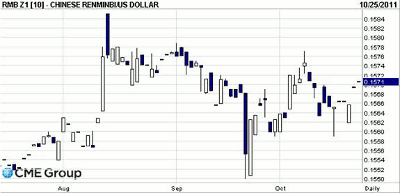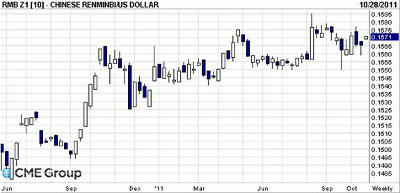For any traders looking to trade the Chinese currency, there is a now a futures contract on the Chinese renminbi listed at CME Group, says Larry Schneider of Zaner Group.
China’s currency, the yuan (also known as the renminbi) can be traded at CME Group just like euro, yen, and Swiss franc futures. The important caveat which we must stress early in this article is that the present volume and open interest make daytrading and swing trading far more difficult than these other futures contracts. It is our opinion that the current state of the market is better suited to position trading.
While there may be some forex dealers that will offer trading in the renminbi in the retail off-exchange forex marketplace, our FDM partners do not. This is likely to change in the coming months, as the state-controlled Bank of China has begun to allow trading in the renminbi in the US.
“The decision is the latest move by China to allow the yuan, whose value is still tightly controlled by the government, to become an international currency that can be used for trade and investment.” (Source: Lingling Wei; Wall Street Journal; January 12, 2011)
“The Chinese renminbi—or RMB—has experienced rapid growth in deposit and trading volume both on- and off-shore. The renminbi is now being used for business transactions in multiple off-shore locations which include Hong Kong, Singapore, Korea, Australia and other areas around the world. Accordingly, a need for capital risk management tools for the Chinese currency has emerged.” (Source: CME Group Web site; October 7, 2011)
However, the trading focus of this article will be on the futures contract. The current USD/RMB futures contract is based on 1,000,000 renminbi and is quoted in USD. CME Group recently launched two indirect quoted versions of the renminbi:
- An RMB/USD contract based on $100,000 and priced in yuan
- A micro-sized RMB/USD contract based on $10,000 and priced in yuan
The three variations of the Chinese currency futures contracts will all trade simultaneously, and it is anticipated that the “market” will determine which contract will emerge with the relative best liquidity.
NEXT: Renminbi Futures Contract Highlights
|pagebreak|Renminbi Futures Contract Highlights
| Contract Size | 1,000,000 Chinese renminbi |
| Contract Month Listings | Thirteen consecutive calendar months plus two deferred March quarterly cycle contract months |
| Settlement Procedure | Cash-settled |
| Ticker Symbol | RMB (CME Globex symbol) |
| Minimum Price Fluctuation (Tick) | $0001 per Chinese renminbi increments ($10/contract). $.000005 per Chinese renminbi increments ($5.00/contract) for RMB/USD futures intra-currency spreads |
| Trading Hours (GLOBEX) | Sundays: 5:00 pm – 4:00 pm Central Time (CT) next day. Monday-Friday 5:00 pm – 4:00 pm CT the next day; except on Friday (4:00 pm close and reopens Sunday at 5:00 pm CT. |
| Initial Margin Requirement (as of October 6, 2011) | $1,620 |
| Contract Value | $157,200 (based on the October 5, 2011 settlement price of $.157200 for the December 2011 contract) |
| October 17, 2011 Launch | |
| Contract Size | 100,000 USD |
| Settlement Procedure | Cash-settled |
| Ticker Symbol | CNY (CME Globex symbol) |
| Minimum Price Fluctuation (Tick) | Quoted in 0.0010 RMB per USD = 100 RMB |
| October 17, 2011 Launch – Micro Contract | |
| Contract Size | 10,000 USD |
| Settlement Procedure | Cash-settled |
| Ticker Symbol | MNY (CME Globex symbol) |
| Minimum Price Fluctuation (Tick) | Quoted in 0.0010 RMB per USD = 10 RMB |
December 2011 Contract
Daily bar chart as of October 26, 2011:
Weekly Continuation Candlestick Chart
Chart for May 2010 through week ending October 21, 2011:
NEXT: Recent Spot Market Price History
|pagebreak|Recent Spot Market Price History
“Between December 2009 and December 2010, the value of the renminbi, climbed at a nominal rate of 2.7% against the US dollar – or a real rate of 7.7%, which adjusts for China’s steep inflation.” (Source: Wall Street Journal; January 18, 2011)
“China’s central bank set the yuan’s official reference rate at a high even as global investors continued to push the currency lower, suggesting that Beijing will continue to let the Chinese currency strengthen despite global economic jitters.” (Source: Wall Street Journal; September 27, 2011; “Beijing Guides the Yuan Higher,” by L. Wei)
“In September [2011] the yuan got a boost from its close association with the dollar. The currency, also known as the renminbi, is held to a narrow trading band by China’s central bank. China raised that range by about 4% this year, including nine increases in September. This means that the yuan’s real effective exchange rate, jumped 2.3% in September to its highest point since China granted the yuan some flexibility in June 2010, according to J.P. Morgan.” (Source: Wall Street Journal; October 5, 2011; “Yuan Shows Its Strength, by E. McCarthy and S. Hong)
“A man who does not plan long ahead will find trouble at his door.” This homage to the importance of having a plan is attributed to the Chinese philospher, Confucius. Although there is no evidence he was also a futures trader, we can still learn from his observation; except today, we say "Plan the Trade and Trade the Plan." Download your free copy of the Trading Plan Template.
To learn how CME Group determines the final settlement price for Renminbi futures, see CME Group Rule 27002.B, Cash Settlement at CME Group’s online Rule Book.
By Larry Schneider of Zaner Group
NOTE: Past performance is not indicative of future price movements. All known news and events have already been factored into the price of the underlying currency.
Futures trading is speculative in nature and involves substantial risk of loss. You should carefully consider whether trading is right for you in light of your knowledge, circumstances, and financial resources. Trading in futures, options, and forex is not suitable for all investors.
Trading in thinly traded contracts, such as the Chinese renminbi, carries additional risks, including slippage and potentially wide bid/offer spreads. This may make it difficult to initiate or liquidate a position close to the last traded price.























